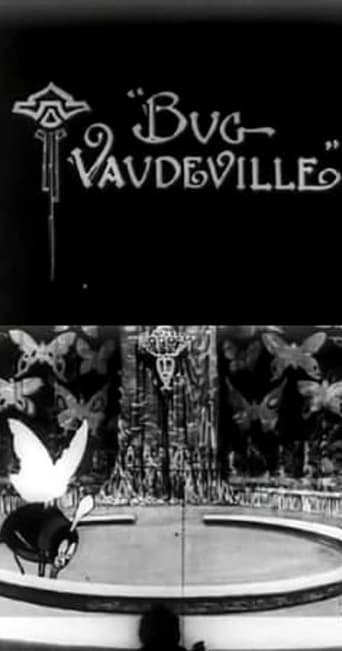Boba_Fett1138
Since I, as part of a modern audience, already felt entertained by this movie, I can only imaging how people must have looked at this movie back in 1921. Animated movies and short were of course still something new back then and it was also far from perfected but this movie simply serves its purpose, to entertain, quite well.It's the second hand-drawn movie done by Winsor McCay, which he based on his own comic-strip 'Dreams of the Rarebit Fiend'. It shows that McCay definitely had a bigger talent for drawing animals than for humans, when it comes down to his work for animated movies. All of the movements by the animals seem far more smooth and they also look quite good.Watching this movie really is like watching a vaudeville act, featuring bugs. This is what makes the movie real entertaining to watch and also keeps sure that there is always something going on. It's a fast going movie, that doesn't have to waste any time on a story or characters.A movie that's still quite entertaining to watch, even by todays standards.8/10http://bobafett1138.blogspot.com/
F Gwynplaine MacIntyre
Winsor McCay's 1921 cartoon 'Bug Vaudeville' has almost precisely the same plot and premise as Karel Capek's stage satire 'The Insect Play', which was first produced in Czechoslovakia in 1922. I wonder if Capek saw McCay's cartoon.We have here a series of variety turns by various species of insects and arachnids. In several cases, McCay amusingly matches a particular vaudeville act to an appropriate species: a daddy-long-legs does an eccentric dance, while two tumble-bugs perform as acrobats. Some of the other pairings of species and performance seem more arbitrary: the potato bugs stage a boxing match, while a cockroach is a bicyclist.McCay uses a framing device to include 'Bug Vaudeville' in his sporadic series of 'Dreams of the Rarebit Fiend' cartoons: a tramp has cadged some cheese from a housewife, and the bugs' antics are apparently his cheese-induced nightmare. In Capek's play, the tramp's slumber is induced by alcohol, and the antics of the various insects are parodic reflections of various forms of human behaviour.'Bug Vaudeville' is amusing, and skilfully animated, but insects just don't seem to work well as cartoon characters, unless most of their distinctive appearance (and behaviour) is removed. The Fleischer Studio's 'Mr Bug Goes to Town' was a flop, even when re-released with a non-insect title, and Walt Disney famously had almost every insect trait shorn from Jiminy Cricket until the character was essentially a miniature human.McCay, a major newspaper cartoonist in his day, made very few animations because his toons were so labour-intensive: McCay executed all the drawings himself, without the use of 'in-betweeners'. In his early toons, he drew on paper rather than acetate cels, forcing McCay to re-draw background art even when the background didn't change.Sadly, almost none of McCay's original artwork survives. In 1982, I interviewed American comic-book artist Leonard B Cole, who worked alongside artist Robert McCay (Winsor's son) in the 1940s. Cole told me that McCay once brought a large quantity of his father's artwork to the studio where they worked, and offered to give it away to any artist who would take it. There were no takers, so McCay simply threw out the lot! (Cole spent a long time regretting his decision to decline the offer.) Today, those illustration boards would be priceless. I'll rate 'Bug Vaudeville' 8 out of 10. It's not very funny, but it's impressively made.
Snow Leopard
This is a creative and detailed Winsor McCay animated feature that is very enjoyable to watch, and it is fortunate that it is one of the surviving movies from his 'Rarebit Fiend' series. The idea itself is clever, and while it is a simple concept, the amusing details and expert technique make it work quite well.The dream about the "Bug Vaudeville" show opens up a lot of possibilities, and McCay does not let them go to waste. There is a series of interesting insects and arachnids who perform various feats of skill. They are cleverly drawn, and the backgrounds also contain some good detail. Most of their 'acts' are interesting and amusing to watch, and they show a resourceful sense of humor on McCay's part.Like most of the pioneers of the movie industry, McCay usually seemed to have a good feel for how much material there really was in one of his subjects. He gets lots of good mileage here out of the "Bug Vaudeville" idea, yet he also stops while the material is still fresh, instead of dragging out some extra footage from it. It's an enjoyable short feature, and a fine example of McCay's skill.
bbenzon
So, for those who haven't seen it, let me tell you about "BugVaudeville." It is framed as a dream. This indigent character goesto sleep under a tree and dreams a series of vaudeville actsplayed by bugs -- roaches, a daddy long-legs, butterflies, andothers. During these acts we see the head and shoulders of thedreamer at the bottom of the screen, rather small, so you don'tnotice them much. The last act is presented as involving a spiderand a fly. The scene is lush vegetation. A spider drops down fromthe top and hangs from a single thread of silk. The spider doesvarious things and goes on and on until you begin to wonder:Where's the fly? And then the spider reaches down to the bottomof the screen and grabs the small black silhouette, pulls it up -- itis not a fly, of course, it's a man, struggling against the spider -- and quickly devours it.End of dream.
